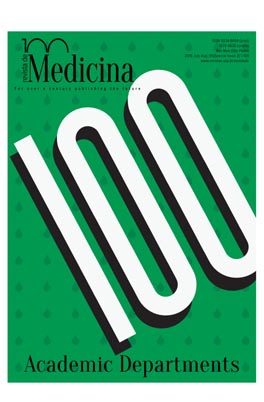Contributions of genetically-modified animal models to the understanding and intervention in autosomal dominant polycystic kidney disease: present and future
DOI:
https://doi.org/10.11606/issn.1679-9836.v95ispe2p10-21Palavras-chave:
Animals, genetically modified, Kidney diseases/genetics, Polycystic Kidney, Autosomal Dominant.Resumo
Autosomal dominant polycystic kidney disease (ADPKD) is the most prevalent monogenic renal disease, representing the fourth cause of end-stage kidney disease. This disorder occurs due to mutations in the PKD1 (Polycystic Kidney Disease 1) or PKD2 (Polycystic Kidney Disease 2) genes, with most of the cases caused by mutations in PKD1. The products of these genes, polycystin-1 (PC1) and polycystin-2 (PC2), are integral membrane glycoproteins that form a complex expressed in the surface of primary apical cilia of several cells, including renal tubular cells. Such proteins are also expressed in other subcellular sites. PC2 functions as a non-selective cation channel with high permeability to calcium, while PC1 is thought to function as a membrane receptor and likely as an adhesion molecule. Since the discovery and characterization of PKD1 and PKD2, the generation of genetically-modified animal models has prompted remarkable advances in the elucidation of ADPKD pathogenesis and identification of potential therapeutic targets. Such animals included knockout, knockin and spatial and temporal conditional knockout models. These progresses allowed the recognition of a complex genetic network involved in the modulation of polycystic kidney disease and the identification of potential modifiers of ADPKD. The mentioned advances also allowed the performance of strategic preclinical studies in mouse models orthologous to this disease, creating appropriate platforms to support robust clinical trials. The generation of composed mutants will likely lead to progressively more complex and specific analyses of ADPKD pathogenesis in the next decades, with meaningful clinical consequences. Moreover, the technical complexity and speed of generating strategic genetically-modified animal models has dramatically improved in recent years, considerably expanding the possibilities for the coming future. In addition, recently developed in vitro approaches such as induced pluripotent stem cells, kidney-on-a-chip and kidney organoid technologies are thought to bring robust and complementary future inputs to the understanding and therapy directed to ADPKD.Downloads
Os dados de download ainda não estão disponíveis.
Downloads
Publicado
2016-08-29
Edição
Seção
Articles
Como Citar
Amaral, A. G., Watanabe, E. H., & Onuchic, L. F. (2016). Contributions of genetically-modified animal models to the understanding and intervention in autosomal dominant polycystic kidney disease: present and future. Revista De Medicina, 95(spe2), 10-21. https://doi.org/10.11606/issn.1679-9836.v95ispe2p10-21




